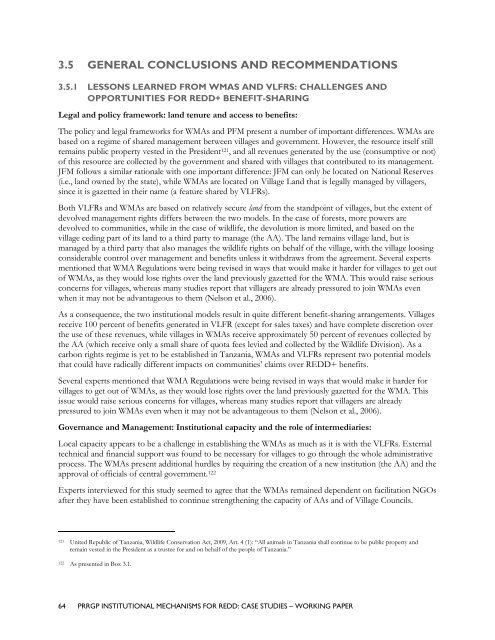Institutional Mechanisms for REDD+ - Case Studies Working Paper
Institutional Mechanisms for REDD+ - Case Studies Working Paper
Institutional Mechanisms for REDD+ - Case Studies Working Paper
Create successful ePaper yourself
Turn your PDF publications into a flip-book with our unique Google optimized e-Paper software.
3.5 GENERAL CONCLUSIONS AND RECOMMENDATIONS<br />
3.5.1 LESSONS LEARNED FROM WMAS AND VLFRS: CHALLENGES AND<br />
OPPORTUNITIES FOR <strong>REDD+</strong> BENEFIT-SHARING<br />
Legal and policy framework: land tenure and access to benefits:<br />
The policy and legal frameworks <strong>for</strong> WMAs and PFM present a number of important differences. WMAs are<br />
based on a regime of shared management between villages and government. However, the resource itself still<br />
remains public property vested in the President 121, and all revenues generated by the use (consumptive or not)<br />
of this resource are collected by the government and shared with villages that contributed to its management.<br />
JFM follows a similar rationale with one important difference: JFM can only be located on National Reserves<br />
(i.e., land owned by the state), while WMAs are located on Village Land that is legally managed by villagers,<br />
since it is gazetted in their name (a feature shared by VLFRs).<br />
Both VLFRs and WMAs are based on relatively secure land from the standpoint of villages, but the extent of<br />
devolved management rights differs between the two models. In the case of <strong>for</strong>ests, more powers are<br />
devolved to communities, while in the case of wildlife, the devolution is more limited, and based on the<br />
village ceding part of its land to a third party to manage (the AA). The land remains village land, but is<br />
managed by a third party that also manages the wildlife rights on behalf of the village, with the village loosing<br />
considerable control over management and benefits unless it withdraws from the agreement. Several experts<br />
mentioned that WMA Regulations were being revised in ways that would make it harder <strong>for</strong> villages to get out<br />
of WMAs, as they would lose rights over the land previously gazetted <strong>for</strong> the WMA. This would raise serious<br />
concerns <strong>for</strong> villages, whereas many studies report that villagers are already pressured to join WMAs even<br />
when it may not be advantageous to them (Nelson et al., 2006).<br />
As a consequence, the two institutional models result in quite different benefit-sharing arrangements. Villages<br />
receive 100 percent of benefits generated in VLFR (except <strong>for</strong> sales taxes) and have complete discretion over<br />
the use of these revenues, while villages in WMAs receive approximately 50 percent of revenues collected by<br />
the AA (which receive only a small share of quota fees levied and collected by the Wildlife Division). As a<br />
carbon rights regime is yet to be established in Tanzania, WMAs and VLFRs represent two potential models<br />
that could have radically different impacts on communities‘ claims over <strong>REDD+</strong> benefits.<br />
Several experts mentioned that WMA Regulations were being revised in ways that would make it harder <strong>for</strong><br />
villages to get out of WMAs, as they would lose rights over the land previously gazetted <strong>for</strong> the WMA. This<br />
issue would raise serious concerns <strong>for</strong> villages, whereas many studies report that villagers are already<br />
pressured to join WMAs even when it may not be advantageous to them (Nelson et al., 2006).<br />
Governance and Management: <strong>Institutional</strong> capacity and the role of intermediaries:<br />
Local capacity appears to be a challenge in establishing the WMAs as much as it is with the VLFRs. External<br />
technical and financial support was found to be necessary <strong>for</strong> villages to go through the whole administrative<br />
process. The WMAs present additional hurdles by requiring the creation of a new institution (the AA) and the<br />
approval of officials of central government. 122<br />
Experts interviewed <strong>for</strong> this study seemed to agree that the WMAs remained dependent on facilitation NGOs<br />
after they have been established to continue strengthening the capacity of AAs and of Village Councils.<br />
121 United Republic of Tanzania, Wildlife Conservation Act, 2009, Art. 4 (1): ―All animals in Tanzania shall continue to be public property and<br />
remain vested in the President as a trustee <strong>for</strong> and on behalf of the people of Tanzania.‖<br />
122 As presented in Box 3.1.<br />
64 PRRGP INSTITUTIONAL MECHANISMS FOR REDD: CASE STUDIES – WORKING PAPER

















